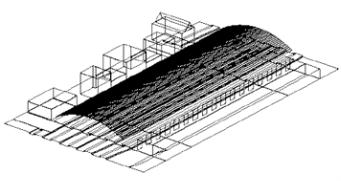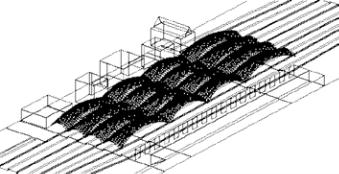SEO Version



61
sound levels are considerably lower than the ones measured underneath the cover.
However, the highest sound levels are kept within acceptable range because of the
sound absorption qualities of the cover material. The sound levels in open air are
higher than - 19 dB(A) in 20% of the positions, underneath the cover these levels
are - 15 dB(A). Sound levels close to the source increase with roughly 4 dB(A). This
limited increase of 4 dB(A) is true for about 60% of the platform area. The remaining
area indicates a higher increase of sound levels, but the initially measured sound
levels in open air for that area were already particularly low.
This analysis indicates that the noise pollution under the cover can be adequately
controlled using a sound absorbing roof. The specific function of sound absorption
and the geometry of the roof are further examined in the next paragraph.
Volume, design and finish of the cover.
The necessary or desired volume of the space under the cover is an important factor
in the acoustic design. This parameter is however not that critical. In the case of
a largely sound absorbing roof, the sound pressure level in the resonance field
decreases to approximately 3 dB(A) when the height, and in this way the volume,
is doubled. Closer to the sound source, the decrease is less. The smallest possible
volume is determined by the minimal height of the cover necessary for the adequate
exploitation of the station. To increase the height of the volume solely for the purpose
of sound control is an (economically) unsound measure; the structure becomes
more expensive and the surface area and cost price of the facades increase as well.
In keeping with the philosophy of the design, the volume was not severely enlarged,
but only partly so, at the centre of the canopies. This still yields a measurable positive
effect on the sound levels, compared with the hypothetically smallest possible
volume.
The shape of the cover is a second important factor. The study of room acoustic
s shows that certain shapes can promote the concentration of sound in certain
specific points, or other undesirable effects. This is why early on in the design
process, a number of different cover shapes were compared with each other in order
to determine the differences in sound level dispersion. The variants have the same
proportions and volume and an identical sound absorption rate, which means that
the results can only differ because of their shape.
The figures 6.1 - 6.3 show the three variants. A new simulation of the sound dispersion
under the cover in the case of a passing train was set up.
The figures 7.1 - 7.3 indicate the dispersion of the sound pressure level on the platform
in three different situations, each with a sound source on track 3, length 100 m,
Lw = 0 dB/m
(fig. 6.3)
.
The comparison between a flat cover
(fig. 7.1)
and a simple arch
(fig. 7.2)
indicates that
the arch tends to amplify the sound parallel to the train tracks. The effect is not
severe, because of the sound absorbing roof, but nonetheless present. The arch is
less “neutral” in terms of sound projection than the more simple flat structure.
A more complex cover, comprising of sixteen modules, parabolically curved in two
directions, was selected for the competition design. The calculated level of sound
dispersion
(fig. 4.2)
indicates that the sound amplifying effect of the arches is largely
diminished, precisely because of the division of the cover structure into smaller
modules with a relatively slight curve. The shape of the roof in a way isolates the
fg 6.3
the competition design (principal form)
fg 6.1
fg 6.2
Powered by FlippingBook Publisher

